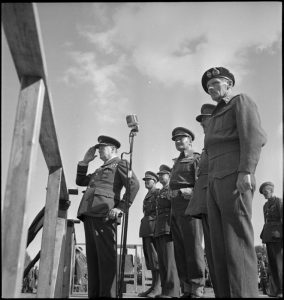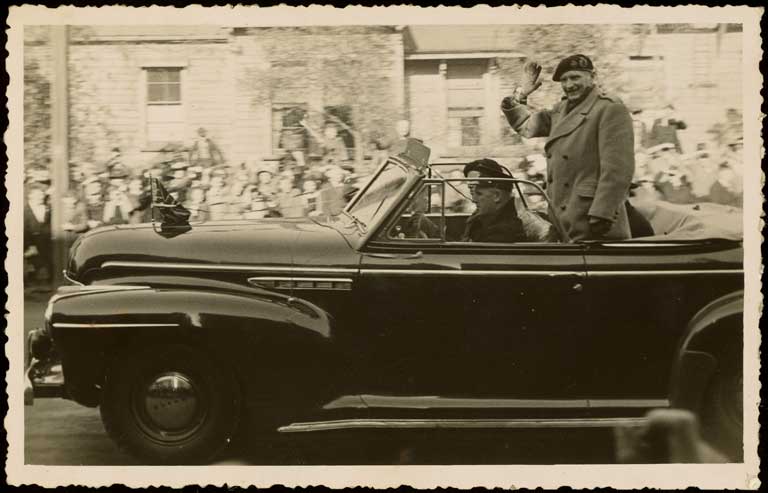Those of us who remember a certain movie from the 1990's may jump to particular conclusions of what the "Monty tour" may be. It actually was the 1947 tour of Australasia by Field Marshal Bernard Montgomery, 1st Viscount Montgomery of Alamein. Born in 1887 and active in both the First and Second World Wars, he gained two nick-names; "Monty" and the "Spartan General".
Monty commanded many New Zealand and Australian soldiers during World War Two. He was assumed command of the Eighth Army in North Africa after the failed first battle of El Alamein on the 13th August 1942. He planned and re-strategised for the next offensive at El Alamein which began on the 23rd of October that same year. This was a decisive battle for Winston Chrurchill's wartime leadership and said of the two battles "At El Alamein we survived; after that we conquered." Approximately 200,000 Allied soldiers were involved in the fighting with 4000 losing their lives and 9000 being wounded under Monty's command in the 12 day battle.
Monty aspired to have "The capacity and the will to rally men and women to a common purpose, and the character which inspires confidence". Charismatic and single-minded, he was popular with the soldiers under his command as he went out of his way to meet and talk with them, but often not liked by his fellow senior offices due to his strong opinions, and particularly not with the American General George Patton. He became one of the most decorated soldiers of World War Two gaining the highest rank of Field Marshal, and was appointed as Chief of the Imperial General Staff after the war and then as Deputy Supreme Commander for the North Atlantic Treaty Organization (NATO).
Invited by the Governments of Australia and New Zealand to visit each country, Monty was in New Zealand from the 16th to 31st of July 1947. Received with much fan-fare throughout the country, Christchurch was no exception. Arriving on the 22nd of July to reputedly one of the biggest crowds in the city's history. People lined the streets for seven miles to catch a glimpse of Monty in his famous black beret, some had even made periscopes to get a better view. Travelling in an open air car allowed him to stand and wave as his cavalcade passed on its way to the King Edward Barracks for the official reception. Reportedly 10,000 citizens crammed themselves into the Barracks for the civic ceremony, many more remained on the surrounding streets.
Visiting Coronation, Burwood and Christchurch Public Hospital's, and attending a reception at the Returned Services' Association were among the itinerary for rest of the day. He was presented with a Kaiapoi travelling rug and a carved walking stick as part of the R.S.A. Reception. He talked with returned service men and women, reminiscensing about countries and places visited during the war, including Captain Charles H. Upham, V. C. He also apologised for his incorrect dress, in that he was wearing a life membership N.Z.R.S.A. badge, even though he was still in active service, and that they had been comrades in war, they could now be comrades in peace.

In an interview with The Press, he said admiringly of the New Zealand soldier, "They have a very independent type of spirit...They will accept a loose framework of control, but you have to make it as loose as possible and you will get value by giving them full scope for their initiative." The Press, Tuesday, July 22 1947.
Many photographers, both professional and amateur were out wanting to capture their permanent reminder of Monty. The National Film Unit was also there to capture some of his itinerary.
Monty later wrote in his memoirs of the tour:
It would be difficult to find words to describe my feelings during my visit to these two Dominions, whose soldiers had fought under my command in the war. I was received everywhere with a depth of affection which seemed at all times to be genuine, warm and sincere. I knew that the warmth of the greeting was not meant for me personally but for that which I represented; it was an expression of appreciation of the bravery and devotion of duty to the men that I had commanded.
The Memoirs of Field-Marshal The Viscount Montgomery of Alamein, K.G., 1958, pg. 460.
With the passing of time and studies by various historians, Field Marshal Montgomery as a man and a commander within the British Army has come to be viewed with a certain level of contradiction and controversy. To learn more about Monty from varying perspectives including his own, his brother's, his aide's during WWII and historians, search our catalogue.
More Christchurch history
To see more of what happened this week in the past, visit our Christchurch Chronology.
Explore local images and Share your photos
- Visit the Discovery Wall and upload your images
- Explore Canterbury Stories
- View more Picturing Canterbury posts





Add a comment to: Week in History 17-23 July – The “Monty tour” arrives in Christchurch 70 years ago